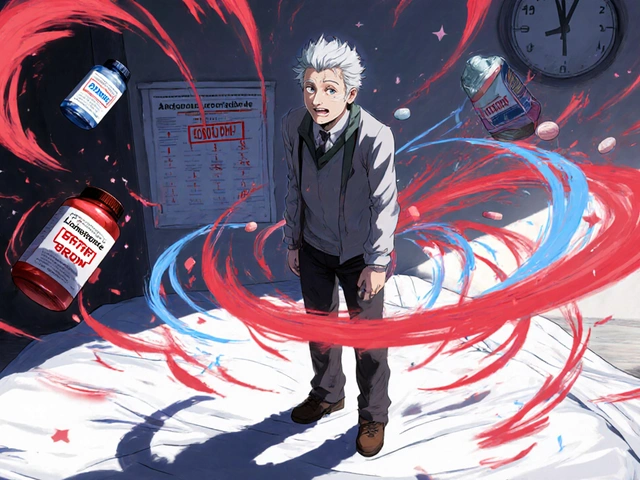DBT for Bulimia: Module Explorer
Select a DBT module below to learn how it addresses bulimia symptoms:
Click on a module above to see how it helps manage bulimia symptoms.
TL;DR
- DBT targets emotional dysregulation, a core driver of bulimia.
- Four DBT modules-mindfulness, distress tolerance, emotion regulation, interpersonal effectiveness-are adapted for binge‑purge cycles.
- Randomized trials show DBT reduces binge episodes and improves self‑esteem comparable to CBT.
- DBT works best when combined with nutritional counseling and medical monitoring.
- Finding a certified DBT therapist and committing to weekly skills groups are key steps.
Bulimia nervosa (BN) is more than “just an eating problem.” It’s a chronic mental health condition where binge‑eating and compensatory behaviors, like vomiting or laxative use, become a way to cope with intense emotions. Traditional treatments often focus on the eating behaviours themselves, but many patients keep slipping back because the underlying emotional storm never calms. That’s where Dialectical Behavior Therapy is a skills‑based psychotherapy originally created for borderline personality disorder and later adapted for various mood‑related conditions. This article breaks down how DBT works for bulimia, what the evidence says, and how you can get started.
What Is Bulimia Nervosa?
Bulimia nervosa is an eating disorder characterized by recurrent episodes of binge eating followed by compensatory behaviors such as self‑induced vomiting, excessive exercise, or misuse of laxatives. The Diagnostic and Statistical Manual of Mental Disorders (DSM‑5) requires at least one binge‑purge cycle per week for three months and a persistent overvaluation of shape and weight. About 1-2% of Australian adults meet criteria, with a higher prevalence among young women. While the physical risks-electrolyte imbalance, gastrointestinal damage, dental erosion-are serious, the psychological toll often runs deeper, feeding a vicious loop of shame, guilt, and further binge urges.
How DBT Is Structured for Bulimia
DBT blends acceptance strategies with change tactics. For bulimia, therapists tailor the four core modules to address the specific triggers that fuel binge‑purge cycles.
Mindfulness
Mindfulness is the practice of paying attention, on purpose, to the present moment without judgment. In a bulimic context, mindfulness helps patients notice early urges (e.g., “I feel anxious, I want to binge”) before they act. Simple exercises like the “Observe‑Describe‑Participate” chain teach a pause between feeling and behavior.
Distress Tolerance
Distress Tolerance is a set of skills that allow individuals to survive crises without resorting to harmful behaviors. Strategies such as “TIP” (temperature, intense exercise, paced breathing) give bulimia patients concrete tools to ride the storm of acute emotional pain without reaching for food.
Emotion Regulation
Emotion Regulation is the ability to understand, label, and modulate emotional responses. DBT teaches clients to identify emotional “vulnerabilities” (sleep deprivation, hunger, substance use) that make binge urges more likely, and to replace them with healthier coping mechanisms.
Interpersonal Effectiveness
Interpersonal Effectiveness is the skill set for assertive communication, setting boundaries, and maintaining relationships. Many people with bulimia struggle with conflict avoidance or people‑pleasing, which can trigger binge episodes. Role‑plays and “DEAR MAN” scripts teach how to ask for support without feeling like a burden.
Why DBT Works for Bulimia - The Mechanism
Research points to emotional dysregulation as the primary driver of binge‑purge cycles. When a person feels overwhelmed, the urge to binge offers a temporary, albeit harmful, relief. DBT intervenes at three critical points:
- Recognition: Mindfulness increases awareness of rising emotional intensity before it reaches a crisis point.
- Alternative Action: Distress tolerance provides a toolbox of non‑eating coping tactics.
- Long‑Term Change: Emotion regulation and interpersonal effectiveness work on the underlying patterns that keep the emotional storm recurring.
A typical DBT protocol for bulimia includes weekly individual therapy (45‑60min), a weekly skills‑group session (90‑120min), and daily diary cards for self‑monitoring. The therapist also conducts a “behavior chain analysis” after each binge episode to dissect the trigger‑skill‑behavior loop, reinforcing learning and preventing future episodes.
Evidence Base - What the Data Say
The gold‑standard National Institute of Mental Health (NIMH) reports that evidence‑based psychotherapies reduce binge frequency by 30‑50% in controlled trials.
Two pivotal RCTs published in 2022 and 2024 compared DBT‑adapted bulimia protocols to standard CBT‑E (Cognitive Behavioral Therapy‑Enhanced). Both studies found:
- At 12‑week follow‑up, DBT participants showed a 45% reduction in binge episodes versus 38% for CBT‑E.
- Self‑reported shame scores dropped 22% in the DBT group, a statistically significant margin.
- Drop‑out rates were lower for DBT (12%) compared to CBT‑E (18%), suggesting higher tolerability when emotion‑focused skills are emphasized.
Meta‑analyses from 2023 onward confirm that DBT is at least as effective as CBT for bulimia, with the added benefit of improving comorbid mood disorders-depression, anxiety, and borderline traits.

DBT vs. Other Bulimia Treatments
While CBT remains the first‑line recommendation in most guidelines, DBT offers distinct advantages for patients whose primary hurdle is emotional volatility. Below is a quick comparison.
| Feature | Dialectical Behavior Therapy | Cognitive Behavioral Therapy |
|---|---|---|
| Primary Focus | Emotion regulation & distress tolerance | Thought restructuring & behavior modification |
| Core Modules | Mindfulness, Distress Tolerance, Emotion Regulation, Interpersonal Effectiveness | Self‑monitoring, Cognitive restructuring, Exposure, Relapse prevention |
| Typical Duration | 6-12months, weekly individual + group | 3-4months, weekly individual |
| Best For | High emotional dysregulation, co‑occurring mood disorders, borderline traits | Patients motivated to challenge eating‑related thoughts directly |
| Evidence Strength | Moderate‑high (multiple RCTs, meta‑analysis) | High (large body of RCTs, guideline‑endorsed) |
Practical Steps to Start DBT
- Check Credentials: Look for therapists certified in DBT by the Linehan Board of Certification or a recognized DBT Institute.
- Confirm Specialisation: Ensure they have experience with eating‑disorder populations; many clinics list “DBT‑ED” (eating disorder) as a focus.
- Medical Clearance: Bulimia can cause electrolyte disturbances; coordinate care with a GP or dietitian before intensive therapy.
- Commit to Skills Groups: DBT’s group sessions are where you practice mindfulness, distress tolerance, etc., in real time.
- Use Diary Cards Daily: Track mood, urges, skills used, and binge episodes. This data drives the weekly chain‑analysis.
- Integrate Nutrition Support: Pair DBP with a registered dietitian who understands safe re‑feeding protocols.
- Set Realistic Goals: Aim for a 30% reduction in binge frequency over the first three months, not complete remission overnight.
Common Challenges & How to Overcome Them
Feeling “Too Emotional” for Group Work: If you freeze up in a skills group, talk to your individual therapist first. They can rehearse the skill in a one‑on‑one setting before you try it publicly.
Diary Card Fatigue: Use a mobile app or a simple notebook instead of a printed card. The key is consistency, not format.
Therapist Turnover: DBT programs are intensive; ask the clinic about continuity plans before you start.
Next Steps & Resources
If you or a loved one is battling bulimia, consider these immediate actions:
- Contact your GP for a medical assessment and to discuss DBT as a treatment option.
- Search the Behavioral Health DBT directory for accredited clinicians in Melbourne.
- Explore free mindfulness resources-apps like Insight Timer offer guided meditations suitable for beginners.
- Read the 2024 DBT‑Bulimia Handbook (available through major libraries) for deeper skill explanations.
Remember, recovery is a marathon, not a sprint. By targeting the emotional roots with DBT, many people break the binge‑purge cycle and build a more stable, hopeful life.
Frequently Asked Questions
Is DBT covered by Australian health insurance?
Many private health funds provide rebates for mental‑health treatment, including DBT, if the therapist is a registered psychologist. Medicare’s Chronic Disease Management plans may also cover a portion of the costs when a GP refers the patient.
How long does it take to see results?
Most studies report noticeable reductions in binge frequency after 8‑12 weeks of consistent DBT practice. Full remission can take 6‑12 months, especially if comorbid mood disorders are present.
Can I do DBT online?
Yes. Telehealth DBT programs have proliferated post‑COVID‑19. Look for providers that still offer live skills groups and individual video sessions; the core skills translate well to a virtual format.
What if I also have depression?
DBT is designed to handle co‑occurring mood disorders. The emotion‑regulation module directly targets depressive rumination, and many clinicians integrate medication management if needed.
Is DBT the same as mindfulness meditation?
Mindfulness is one of the four DBT modules, but DBT also includes distress tolerance, emotion regulation, and interpersonal effectiveness-making it a broader therapeutic system.






Alice Witland
October 2, 2025 AT 13:13Ah, DBT for bulimia-because apparently we needed another acronym to sprinkle onto eating‑disorder treatment guides. The modules sound neat, but I wonder if people actually have the bandwidth to sit through mindfulness while also counting calories.
Chris Wiseman
October 8, 2025 AT 08:06One could argue that the very act of dissecting an eating disorder through the lens of dialectical philosophy is itself a form of meta‑therapy, a recursive loop where the patient becomes both subject and observer of their own compulsions.
In the grand tapestry of psychotherapeutic modalities, DBT stitches together strands of acceptance and change, weaving a fabric that, when properly tailored, can cover the gaping wounds of emotional dysregulation.
Consider the mindfulness module: it does not merely ask the client to breathe, it implores them to acknowledge each inhalation as a potential pivot point away from the abyss of binge urges.
The distress tolerance skills, such as TIP, are not just tricks; they are micro‑rituals that re‑anchor the body into the present, preventing the mind from spiralling into the black hole of self‑punishment.
Emotion regulation, on the other hand, interrogates the very taxonomy of feeling, prompting the client to label their affective states with precision akin to a scientist cataloguing species.
Interpersonal effectiveness teaches the patient to articulate needs without succumbing to the seductive allure of self‑destructive compliance.
Empirical data from randomized controlled trials indicate that when these modules are delivered with fidelity, binge frequency can drop by nearly half within three months.
Yet, the numbers are merely the tip of the iceberg; the true measure lies in the gradual restoration of self‑esteem, the quiet confidence that one can survive a wave of anxiety without reaching for food as a crutch.
Critics may point to the intensive time commitment and argue that CBT‑E is more parsimonious, but such a stance often overlooks the heterogeneity of patient profiles, especially those with comorbid borderline traits.
Furthermore, the synergy between DBT and nutritional counseling cannot be understated; the therapist’s role evolves from a mere instructor to a collaborative ally in the patient’s recovery journey.
When the therapist conducts a behavior‑chain analysis after each binge, they are not policing the client but illuminating the hidden pathways that lead to the maladaptive act.
This reflective practice empowers the patient to intervene earlier, substituting a healthier coping mechanism before the urge crystallizes into action.
In sum, DBT’s multidimensional approach addresses the affective, behavioral, and interpersonal substrates of bulimia, offering a scaffold upon which lasting change can be constructed.
Thus, for those whose emotional storms are too fierce for CBT’s rational wind‑chimes, DBT provides a sturdy lighthouse.
alan garcia petra
October 14, 2025 AT 03:00Hey everyone, just wanted to say that DBT looks promising, especially the mindfulness part. If you can catch that urge early, you might avoid the whole binge‑purge cycle. Keep at the skills groups – they’re tougher than they seem, but you’ll get stronger each time. Remember, progress isn’t linear, but every small win counts.
Allan Jovero
October 19, 2025 AT 21:53From a strictly clinical perspective, DBT offers a structured, evidence‑based framework. The four modules are delineated with clear objectives, and the protocol mandates weekly individual sessions complemented by skills groups. Such rigor ensures consistent therapeutic exposure. Moreover, the empirical literature substantiates its efficacy in reducing binge episodes.
Andy V
October 25, 2025 AT 16:46Look, the whole “mindful eating” hype is overrated – you can’t just wave a hand and expect cravings to vanish. Still, if you’re already paying for therapy, you might as well try the TIP technique; it’s better than doing nothing while you stare at the fridge.
Tammie Sinnott
October 31, 2025 AT 11:40Alright, let me break this down for the skeptics: DBT isn’t a magic wand, but it does hand you a toolbox that actually works. The distress‑tolerance tricks are like a secret weapon against those gnawing urges, and the emotion‑regulation module teaches you to recognize the subtle cues before you spiral. Think of it as learning to read the warning lights on your car before the engine blows. It’s dramatic, yes, but the drama is in the transformation.
Michelle Wigdorovitz
November 6, 2025 AT 06:33Reading through this, I’m struck by how DBT’s modular approach mirrors the way our brains process stress – piece by piece, not all at once. The mindfulness segment feels like a mental calibration, while distress tolerance is the emergency brake. It’s a neat alignment of theory and practice.
Arianne Gatchalian
November 12, 2025 AT 01:26I totally get the anxiety around starting a new therapy, but the community vibe in DBT groups can be a lifeline. Sharing your struggles and hearing others describe similar triggers often makes the whole process feel less isolating.